 W
WChinese ceramics show a continuous development since pre-dynastic times and are one of the most significant forms of Chinese art and ceramics globally. The first pottery was made during the Palaeolithic era. Chinese ceramics range from construction materials such as bricks and tiles, to hand-built pottery vessels fired in bonfires or kilns, to the sophisticated Chinese porcelain wares made for the imperial court and for export. Porcelain was a Chinese invention and is so identified with China that it is still called "china" in everyday English usage.
 W
WAn hua is a term used in Chinese ceramics meaning secret or veiled decoration; the designs being visible through transmitted light, produced either by incising the design into the porcelain before glazing and firing or by delicate slip-trailing in white slip on the porcelain body. It is also called "secret" or "hidden decoration".
 W
WCeladon is a term for pottery denoting both wares glazed in the jade green celadon color, also known as greenware, and a type of transparent glaze, often with small cracks, that was first used on greenware, but later used on other porcelains. Celadon originated in China, though the term is purely European, and notable kilns such as the Longquan kiln in Zhejiang province are renowned for their celadon glazes. Celadon production later spread to other parts of East Asia, such as Japan and Korea as well as Southeast Asian countries such as Thailand. Eventually, European potteries produced some pieces, but it was never a major element there. Finer pieces are in porcelain, but both the color and the glaze can be produced in stoneware and earthenware. Most of the earlier Longquan celadon is on the border of stoneware and porcelain, meeting the Chinese but not the European definitions of porcelain.
 W
WA chawan is a bowl used for preparing and drinking tea. Many types of chawan are used in East Asian tea ceremonies. The choice of their use depends upon many considerations.
 W
WCizhou ware or Tz'u-chou ware is a term for a wide range of Chinese ceramics from between the late Tang dynasty and the early Ming dynasty, but especially associated with the Northern Song to Yuan period in the 11–14th century. It has been increasingly realized that a very large number of sites in northern China produced these wares, and their decoration is very variable, but most characteristically uses black and white, in a variety of techniques. For this reason Cizhou-type is often preferred as a general term. All are stoneware in Western terms, and "high-fired" or porcelain in Chinese terms. They were less high-status than other types such as celadons and Jun ware, and are regarded as "popular", though many are finely and carefully decorated.
 W
WClay Figure Zhang is a famous folk art in Tianjin, China. It was created by Zhang Mingshan during the Daoguang reign (1821–50) of the Qing dynasty.
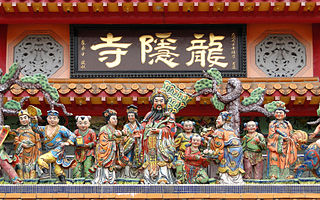 W
WCochin ware, or Jiaozhi ware is a type of Chinese pottery from Guangdong Province, southern China.
 W
WA cong is a form of ancient Chinese jade artifact. It was later also used in ceramics.
 W
WDawu Clay Sculpture is a famous folk art in Chaozhou, Guangdong Province.It is called "Three Chinese clay culpture" with Clay Figure Zhang and Xihui mountain clay.
 W
WDehua porcelain, more traditionally known in the West as Blanc de Chine, is a type of white Chinese porcelain, made at Dehua in the Fujian province. It has been produced from the Ming dynasty (1368–1644) to the present day. Large quantities arrived in Europe as Chinese export porcelain in the early 18th century and it was copied at Meissen and elsewhere. It was also exported to Japan in large quantities.
 W
WDing (鼎) are prehistoric and ancient Chinese cauldrons, standing upon legs with a lid and two facing handles. They are one of the most important shapes used in Chinese ritual bronzes. They were made in two shapes: round vessels with three legs and rectangular ones with four, the latter often called fangding. They were used for cooking, storage, and ritual offerings to the gods or to ancestors. The earliest recovered examples are pre-Shang ceramic ding at the Erlitou site but they are better known from the Bronze Age, particularly after the Zhou deemphasized the ritual use of wine practiced by the Shang kings. Under the Zhou, the ding and the privilege to perform the associated rituals became symbols of authority. The number of permitted ding varied according to one's rank in the Chinese nobility: the Nine Ding of the Zhou kings were a symbol of their rule over all China but were lost by the first emperor, Shi Huangdi in the late 3rd century BCE. Subsequently, imperial authority was represented by the Heirloom Seal of the Realm, carved out of the sacred Heshibi; it was lost at some point during the Five Dynasties after the collapse of the Tang.
 W
WDing ware, Ting ware or Dingyao are Chinese ceramics, mostly porcelain, that were produced in the prefecture of Dingzhou in Hebei in northern China. The main kilns were at Jiancicun or Jianci in Quyang County. They were produced between the Tang and Yuan dynasties of imperial China, though their finest period was in the 11th century, under the Northern Song. The kilns "were in almost constant operation from the early eighth until the mid-fourteenth century."
 W
WA dragon kiln or "climbing kiln", is a traditional Chinese form of kiln, used for Chinese ceramics, especially in southern China. It is long and thin, and relies on having a fairly steep slope, typically between 10° and 16°, up which the kiln runs. The kiln could achieve the very high temperatures, sometimes as high as 1400°C, necessary for high-fired wares including stoneware and porcelain, which long challenged European potters, and some examples were very large, up to 60 metres long, allowing up to 25,000 pieces to be fired at a time. By the early 12th century CE they might be over 135 metres long, allowing still larger quantities to be fired; more than 100,000 have been claimed.
 W
WThe Five Great Kilns, also known as Five Famous Kilns, is a generic term for ceramic kilns or wares which produced Chinese ceramics during the Song dynasty (960–1279) that were later held in particularly high esteem. The group were only so called by much later writers, and of the five, only two seem to have produced wares directly ordered by the Imperial court, though all can be of very high quality. All were imitated later, often with considerable success.
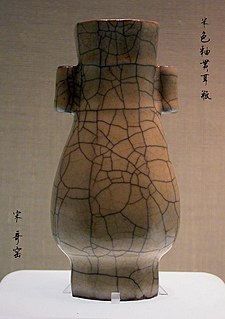 W
WGe ware or Ko ware is a type of celadon or greenware in Chinese pottery. It was one of the Five Great Kilns of the Song dynasty recognised by later Chinese writers, but has remained rather mysterious to modern scholars, with much debate as to which surviving pieces, if any, actually are Ge ware, whether they actually come from the Song, and where they were made. In recognition of this, many sources call all actual pieces Ge-type ware.
 W
WA guang or gong is a particular shape used in Chinese art for vessels, originally made as Chinese ritual bronzes in the Shang dynasty, and sometimes later in Chinese porcelain. They are a type of ewer which was used for pouring rice wine at ritual banquets, and often deposited as grave goods in high-status burial. Examples of the shape may be described as ewers, ritual wine vessels, wine pourers and similar terms, though all of these terms are also used of a number of other shapes, especially the smaller tripod jue and the larger zun.
 W
WGreen-glazed pottery was a type of colored pottery developed in China during the Eastern Han period. The body of green-glazed pottery ceramics was made of clay, coated with a layer of glaze, and fired at a temperature of 800 degrees Celsius. Green-glazed pottery is a type of lead-glazed earthenware : lead oxide was the principal flux in the glaze, often mixed with quartz in the proportion of 3:1. The polychrome effect was obtained by using as coloring agent copper. It is not to be confused with "greenware", another term for celadon-glazed ceramics, which became prominent later.
 W
WGuan ware or Kuan ware is one of the Five Famous Kilns of Song Dynasty China, making high-status stonewares, whose surface decoration relied heavily on crackled glaze, randomly crazed by a network of crack lines in the glaze.
 W
WThe hunping, translated as soul jar or soul vase, is a type of ceramic funerary urn often found in the tombs of the Han dynasty and especially the Six Dynasties periods of early imperial China. It was characteristic of the Jiangnan region in modern southern Jiangsu and Zhejiang provinces.
 W
WJian ware or Chien ware is a type of Chinese pottery originally made in Jianyang, Fujian province. It, and local imitations of it, is known in Japan as Tenmoku (天目). The ware are simple shapes in stoneware, with a strong emphasis on subtle effects in the glazes. In the Song dynasty they achieved a high prestige, especially among Buddhist monks and in relation to tea-drinking. They were also highly valued in Japan, where many of the best examples were collected. Though the ceramic body is light-coloured, the wares, generally small cups for tea, bowls and vases, normally are glazed in dark colours, with special effects such as the "hare's fur" "oil-spot" and "partridge feather" patterns caused randomly as excess iron in the glaze is forced out during firing.
 W
WJizhou ware or Chi-chou ware is Chinese pottery from Jiangxi province in southern China; the Jizhou kilns made a number of different types of wares over the five centuries of production. The best known wares are simple shapes in stoneware, with a strong emphasis on subtle effects in the dark glazes, comparable to Jian ware, but often combined with other decorative effects. In the Song dynasty they achieved a high prestige, especially among Buddhist monks and in relation to tea-drinking. The wares often use leaves or paper cutouts to create resist patterns in the glaze, by leaving parts of the body untouched.
 W
WJun ware is a type of Chinese pottery, one of the Five Great Kilns of Song dynasty ceramics. Despite its fame, much about Jun ware remains unclear, and the subject of arguments among experts. Several different types of pottery are covered by the term, produced over several centuries and in several places, during the Northern Song dynasty (960–1126), Jin dynasty (1115–1234) and Yuan dynasty (1271–1368), and lasting into the early Ming dynasty.
 W
WLongquan celadon (龍泉青瓷) is a type of green-glazed Chinese ceramic, known in the West as celadon or greenware, produced from about 950 to 1550. The kilns were mostly located in Lishui prefecture in southwestern Zhejiang Province in the south of China, and the north of Fujian Province. Overall a total of some 500 kilns have been discovered, making the Longquan celadon production area one of the largest historical ceramic producing areas in China. "Longquan-type" is increasingly preferred as a term, in recognition of this diversity, or simply "southern celadon", as there was also a large number of kilns in north China producing Yaozhou ware or other Northern Celadon wares. These are similar in many respects, but with significant differences to Longquan-type celadon, and their production rose and declined somewhat earlier.
 W
WThe mantou kiln or horseshoe-shaped kiln was the most common type of pottery kiln in north China, in historical periods when the dragon kiln dominated south China; both seem to have emerged in the Warring States period of approximately 475 to 221 BC. It is named after the Chinese mantou bun or roll, whose shape it resembles; the ground plan resembles a horseshoe. The kilns are roughly round, with a low dome covering the central firing area, and are generally only 2 to 3 metres across inside. However it is capable of reaching very high temperatures, up to about 1370°C. There is a door or bricked-up opening at the front for loading and unloading, and one or two short chimneys at the rear.
 W
WA meiping is a type of vase in Chinese ceramics. It is traditionally used to display branches of plum blossoms. The meiping was first made of stoneware during the Tang dynasty (618–907). It was originally used as a wine vessel, but since the Song dynasty (960–1279) it also became popular as a plum vase and got its name "meiping". It is tall, with a narrow base spreading gracefully into a wide body, followed by a sharply-rounded shoulder, a short and narrow neck, and a small opening.
 W
WNiuheliang is a Neolithic archaeological site in Liaoning Province, Northeast China, along the middle and upper reaches of the Laoha River and the Yingjin River. Discovered in 1983, Niuheliang site belongs to the Hongshan culture. It includes evidence of religion, such as a temple, an altar and a cairn.
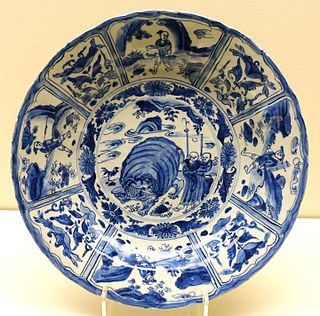 W
WThe Oriental Ceramic Society (OCS) is one of the leading international societies for the study and appreciation of Asian art, with a special interest in ceramics. However its wider focus is the study and appreciation of all aspects of oriental art, and over the last 90 years has served as one of the main bodies assisting the understanding of oriental art, and oriental ceramics in particular, by means of organising regular meetings, lectures and publications.
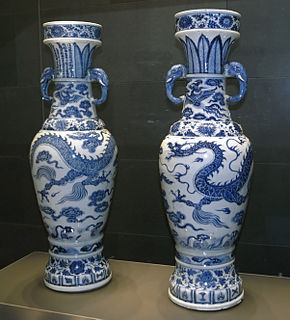 W
WThe Percival David Foundation of Chinese Art holds a collection of Chinese ceramics and related items assembled by Percival David that are on permanent display in a dedicated gallery in Room 95 at the British Museum. The Foundation's main purpose is to promote the study and teaching of Chinese art and culture. The collection consists of some 1,700 pieces, mostly of Song, Yuan, Ming and Qing dynasty porcelain from the 10th century to the 18th. It includes a painting, Scroll of Antiquities.
 W
WProto-celadon was a type of Chinese ceramic which developed during the Shang period and Western Han periods. It is often described as "proto-porcelain", and was usually glazed in light yellowish green.
 W
WThe qīqì was an ancient Chinese ceremonial utensil that automatically overturned and spilled its contents once it reached capacity, thus symbolizing moderation and caution. Both Confucian and Daoist Chinese classics include a famous anecdote about the first time Confucius saw a tilting vessel. In the Confucian tradition it was also named yòuzuò zhī qì, with three positions, the vessel tilts to one side when empty, stands upright when filled halfway, and overturns when filled to the brim—illustrating the philosophical value of the golden mean. In the Daoist tradition, the tilting vessel was named yòuzhī, with two positions, staying upright when empty and overturning when full—illustrating the metaphysical value of emptiness, and later associated with the Zhuangzian zhīyán rhetorical device.
 W
WThe rooster bowl began in China over a hundred years ago by Hakka people in Guangdong Province.
 W
WRu ware, Ju ware, or "Ru official ware" is a famous and extremely rare type of Chinese pottery from the Song dynasty, produced for the imperial court for a brief period around 1100. Fewer than 100 complete pieces survive, though there are later imitations which do not entirely match the originals. Most have a distinctive pale "duck-egg" blue glaze, "like the blue of the sky in a clearing amongst the clouds after rain" according to a medieval connoisseur, and are otherwise undecorated, though their colours vary and reach into a celadon green. The shapes include dishes, probably used as brush-washers, cups, wine bottles, small vases, and censers and incense-burners. They can be considered as a particular form of celadon wares.
 W
WSancai is a versatile type of decoration on Chinese pottery using glazes or slip, predominantly in the three colours of brown, green, and a creamy off-white. It is particularly associated with the Tang Dynasty (618–907) and its tomb figures, appearing around 700. Therefore, it is commonly referred to as Chinese: 唐三彩 Tang Sancai in Chinese. Tang sancai wares were sometimes referred in China and the West as egg-and-spinach by dealers, for their use of green, yellow, and white, especially when combined with a streaked effect.
 W
WShiwan ware is Chinese pottery from kilns located in the Shiwanzhen Subdistrict of the provincial city of Foshan, near Guangzhou, Guangdong. It forms part of a larger group of wares from the coastal region known collectively as "Canton stonewares". The hilly, wooded, area provided slopes for dragon kilns to run up, and fuel for them, and was near major ports.
 W
WTang dynasty tomb figures are pottery figures of people and animals made in the Tang dynasty of China (618–906) as grave goods to be placed in tombs. There was a belief that the figures represented would become available for the service of the deceased in the afterlife. The figures are made of moulded earthenware with colour generally being added, though often not over the whole figure, or in naturalistic places. Where the colouring was in paint it has often not survived, but in many cases it was in sancai ("three-colour") ceramic glaze, which has generally lasted well.
 W
WThe Tang dynasty tomb figures of Liu Tingxun (刘定训) are thirteen earthenware tomb figures found in a tomb believed to be that of Liu Tingxun, a Chinese general who died in 728 AD. These figures were found in Luoyang and are now on display in the British Museum in London. Similar Tang dynasty tomb figures of people and animals from other tombs of the same era can be found in other museums around the world.
 W
WA tea pet, also known as a tea lover's pet, is a small clay figure which is kept by some tea drinkers for good luck. They are usually made of "zisha" or Yixing clay, from the region near Yixing in Jiangsu province, China. Just like Yixing teapots made of the same clay, tea pets are unglazed, so that they are mostly monochromatic with a rough surface. Tea lovers in China raise a tea pet by placing it on the tea tray during tea time and pouring out the tea over it. One of the most popular models for the tea pet is the "pee-pee boy" which when first soaked in cold water and then showered with hot water will squirt out the water it previously absorbed. Tea pets are also molded into zodiac animals or Chinese mythical creatures such as dragons, Pixiu, Qilin, etc., to symbolize good luck, fortune and happiness, as well as historical or mythical characters such as Guanyin, Maitreya and Zhuge Liang.
 W
WXing ware or Xingyao is a type of Chinese ceramics produced in Hebei province, most notably during the Tang dynasty. Xing ware typically has a white body covered with a clear glaze. It was named after Xingzhou in southern Hebei where it was made; kilns sites have been identified in Neiqiu County as well as in Lincheng although Lincheng was not part of Xingzhou during the Tang dynasty. Some Xing wares were fired at a high enough temperature to be considered porcelain by Western definition, therefore Xing ware may be considered the world's first true porcelain. Xing ware was produced from the Northern Qi to the Song dynasty, and its production reached it peak during the Tang dynasty. It was supplanted by Ding ware during the Song dynasty
 W
WYaozhou ware is a type of celadon or greenware in Chinese pottery, which was at its height during the Northern Song dynasty. It is the largest and typically the best of the wares in the group of Northern Celadon wares. It is especially famous for the rich effects achieved by decoration in shallow carving under a green celadon glaze which sinks into the depressions of the carving giving contrasts of light and dark shades.
 W
WA set of life-size glazed pottery sculptures of luohans usually assigned to the period of the Liao dynasty (907–1125) was discovered in caves at I Chou in Yi xian or Yi County, Hebei, south of Beijing, before World War I. They have been described as "one of the most important groups of ceramic sculpture in the world." They reached the international art market, and were bought for Western collections. At least eight statues were originally found, including one large fragment which was long thought to have been destroyed in Berlin during World War II, but has been sighted in Russia recently.
 W
WYixing clay teapots, also called Purple Sand, are made from Yixing clay. This traditional style commonly used to brew tea originated in China, dating back to the 15th century, and are made from clay produced near Yixing in the eastern Chinese province of Jiangsu.
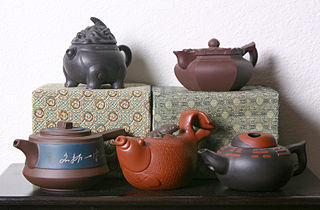 W
WYixing clay is a type of clay from the region near the city of Yixing in Jiangsu Province, China, used in Chinese pottery since the Song dynasty (960–1279) when Yixing clay was first mined around China's Lake Tai. From the 17th century on, Yixing wares were commonly exported to Europe. The finished stoneware, which is used for teaware and other small items, is usually red or brown in colour. Also known as zisha (宜興紫砂) ware, they are typically left unglazed and use clays that are very cohesive and can form coils, slabs and most commonly slip casts. These clays can also be formed by throwing. The best known wares made from Yixing clay are Yixing clay teapots, tea pets, and other teaware.
 W
WYue ware or Yüeh ware is a type of Chinese ceramics, a felspathic siliceous stoneware, which is characteristically decorated with celadon glazing. Yue ware is also sometimes called (Yuezhou) green porcelain in modern literature, but the term is misleading as it is not really porcelain and its shades are not really green. It has been "one of the most successful and influential of all south Chinese ceramics types".